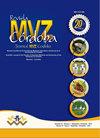Effect of follicular growth promoters on timed artificial insemination in dairy cows.
IF 0.3
4区 农林科学
Q4 AGRICULTURE, DAIRY & ANIMAL SCIENCE
引用次数: 0
Abstract
Objective. To evaluate the efficiency of equine chorionic gonadotropin (eCG) and follicle stimulating hormone (FSH) on the pregnancy rate of crossbred cows from different body condition score (BCS) in the postpartum period in timed artificial insemination (TAI). Material and methods. The cows were subjected to the same hormone protocol: Day zero (D0), progesterone-release intravaginal device (PRID) and 2 mg estradiol benzoate (EB); D8, withdrawal of PRID, application 0.150 mg of prostaglandin. On D8, the animals were distributed into three treatments: 1 – (TeCG; n = 98) injection of 300 IU eCG; 2 – (TFSH; n = 84) injection of 20 mg of FSH and; 3 – (Control; n = 115) without further treatment. On D9, all animals received 1 mg of EB; D10, TAI of all the cows. After 30 days from TAI, ultrasound diagnosis of pregnancy was performed. Results. Pregnancy rate did not differ among eCG (52.04%), FSH (40.47%), and Control (40.00%) treated cows (p>0.05). In cows with low body condition, the pregnancy rate was higher (p<0.05) for cows treated with eCG (41.46%) when compared to FSH (18.18%) and Control (17.07%) cows. The postpartum interval among treatments was similar (p>0.05) (35–65 or 66–95days). Conclusions. The use of eCG or FSH did not result in an increase in the pregnancy rate when compared to the control treatment; however, eCG improved the pregnancy rate of cows with low body condition scores.卵泡生长促进剂对奶牛定时人工授精的影响。
目标。目的探讨马绒毛膜促性腺激素(eCG)和促卵泡激素(FSH)对定时人工授精(TAI)中产后不同体况评分(BCS)杂交奶牛妊娠率的影响。材料和方法。奶牛接受相同的激素方案:第0天(D0),孕激素释放阴道内装置(PRID)和2 mg苯甲酸雌二醇(EB);D8,停用prd,应用前列腺素0.150 mg。在D8,将动物分为3个处理:1 - (TeCG);n = 98)注射300iu心电图;2 - (tfsh;n = 84)注射FSH 20 mg;3 -(控制;N = 115),无需进一步治疗。在第9天,所有动物接受1 mg EB;所有奶牛的D10, TAI。术后30 d超声诊断妊娠。结果。心电图组(52.04%)、FSH组(40.47%)和对照组(40.00%)的妊娠率差异无统计学意义(p < 0.05)。低体况奶牛的妊娠率(35 ~ 65天和66 ~ 95天)较高(p0.05)。结论。与对照组相比,使用eCG或FSH没有导致妊娠率增加;然而,eCG提高了低体况评分奶牛的妊娠率。
本文章由计算机程序翻译,如有差异,请以英文原文为准。
求助全文
约1分钟内获得全文
求助全文
来源期刊

Revista Mvz Cordoba
农林科学-奶制品与动物科学
CiteScore
0.70
自引率
0.00%
发文量
41
审稿时长
6-12 weeks
期刊介绍:
The Journal MVZ Córdoba is an open access international scientific journal financed and edited by the University of Córdoba (Colombia). The journal publishes quarterly, continuously in PDF, XML, Epub, original articles, literature reviews, brief communications and clinical cases, peer-reviewed (double-blind) in Spanish and English, which are related to the agricultural and veterinary sciences. The journal is directed to natural and legal persons of veterinary medicine, animal husbandry, public health, epidemiology, aquaculture, biology, basic biomedical sciences and biotechnology and constitutes a space for academic and scientific discussion around the work of professionals in Veterinary Medicine and Zootechnics. Four-monthly publication.
"The Journal MVZ Córdoba supports the policies for registration of clinical trials of the World Health Organization (WHO) and the International Committee of Medical Journal Editors (ICMJE), since it recognizes the importance of these initiatives for international registration and dissemination. of information about clinical studies, in open access. As a result, since 2007, the journal MVZ Córdoba only publishes clinical research articles that have received an identification number in one of the Clinical Trial Registries validated by the criteria established by WHO and ICMJE, whose addresses are available in the ICMJE website. The identification number is recorded at the end of the summary. "
 求助内容:
求助内容: 应助结果提醒方式:
应助结果提醒方式:


